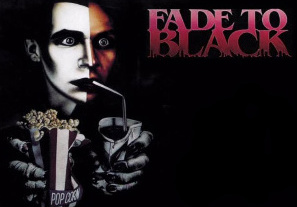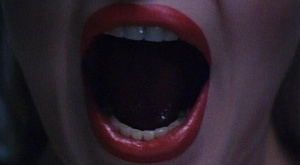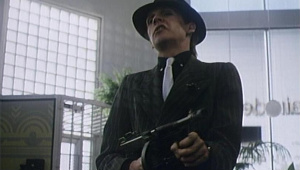
Some people take their love of movies a little too far. Take Scream, for instance. 1980’s Fade to Black was the natural conclusion for fanboy obsession, with the movie’s protagonist becoming literally engulfed in the fantasy worlds which he so adored. Whereas most slashers of the era drew their inspiration from John Carpenter’s Halloween, this film instead looked further afield, with an array of cinematic references reaching as far back as Creature from the Black Lagoon (1954), White Heat (1949) and even Nosferatu, eine Symphonie des Grauens (1922). The tone constantly shifts between genres, from horror to film noir, making Fade to Black one of the more schizophrenic slasher films. Whereas many movies of the era justified their maniac’s actions with a simple backstory, here we watch as the disturbed central character slowly descends into madness as he fantasises over the silver screen and Marilyn Monroe. Released not only during the heyday of the slasher but also at a time when pop culture and merchandise were starting to draw attention to the viewer’s fascination with every aspect of filmmaking, Fade to Black could have been one of the most important flicks of its era but sadly, due to poor marketing, quickly slipped into obscurity.
Eric Binford (Dennis Christopher) is a lonely and disturbed young man. A constant victim of his auntie’s bitter rage and his colleagues cynicism, Eric spends the hours locked in his room surrounded by movie memorabilia whilst reliving his favourite screen moments in front of a projector. He has no friends, people look down on him like he is pathetic and he finds it almost impossible to connect with anyone. His only joy is his menial job at a film distribution warehouse, though his aspirations of one day becoming an important figure in the industry leaves him bitter and disillusioned. To while away the hours, he plays movie trivia games with two of his co-workers (including a pre-fame Mickey Rourke), incurring their wrath when he catches them out on a bet by quizzing them on the surname of Casablanca‘s hero. But one evening, his wheelchair-bound aunt (Eve Brent Ashe) pushes him too far and, in a fit of rage, pushes her down the stairs in a homage to Richard Widmark in Kiss of Death. He soon develops an interest in Marilyn Monroe look-a-like Linda Kerridge, although this soon turns to obsession and, when she eventually rebuffs him, even homicidal. Meanwhile, Jerry Moriarty (Tim Thomerson) is new in town and working as a police psychiatrist, eventually becoming involved in a murder case which will inevitably one day lead him to Eric.

The success of Fade to Black depended on its central character and the performance of the actor. Eric Binford is a surprisingly complex individual, a three-dimensional antihero who first wins over the viewer’s sympathy before embarking on a murder spree that sees him targeting all those who wronged him, whilst dressed in a manner if disguises, each referencing his favourite movies. For the scene in which he dispatches of Richie (Rourke) and his deadbeat friend, he adopts the visage of Hopalong Cassidy to challenge them to a Mexican standoff, before stalking through Marilyn’s house like Nosferatu and then entering her bathroom as she shallows in an explicit tribute to Psycho. There is an air of tragedy throughout the movie, as it clear from the get-go that this can only end in disaster, though Eric succeeds in finally achieving his dream, going out in a hail of bullets in a nod of the hat to Cary Grant in To Catch a Thief, as a police spotlight illuminates him as he stands proud looking over the city from the roof of Hollywood’s Chinese Theater.
But the screenplay, expertly crafted by director Vernon Zimmerman, would be redundant if it were not for the star-making turn by Christopher, who lifts Eric up from what could have been a cardboard caricature and succeeds in presenting his protagonist with an intense and touching performance. Managing to balance such stylish scenes as Eric brandishing a Tommy Gun and thirties-style suit and Fedora to assassinate a film producer who plagiarised his movie concept with moments of melancholy as he walks aimlessly through the city streets from one late-night screening to another, Christopher helps keep the viewer’s interest, even in the weaker moments of the script. Produced by Irwin Yablans, who had previously been responsible for the success of Halloween, Fade to Black should have been one of the defining moments of the slasher genre in the early eighties, as it is far superior to the likes of Prom Night and The House on Sorority Row, but due the usual kind of industry politics that constantly dig the genre, the movie failed to get the kind of recognition it so richly deserved.


5 Responses to Fade to Black (1980)